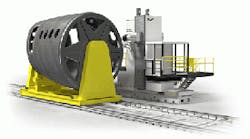Machine tool developer MAG designed a 6-axis FTR AutoDrill for installation at Boeing’s new South Carolina plant, a system that combines a rigid boring mill chassis and an extended-reach ram with a “nimble” gimbal head, so the system will execute high-precision milling and drilling steps on oversized structures built of composites or sandwich materials. Also, the first FTR AutoDrill is equipped with MAG's multi-patented MQC (Minimum Quantity Cryogenic) tool cooling technology.
The FTR AutoDrill is a modular design that MAG will make available in various sizes, and it will accommodate many tool-types and sizes, both fixed and rotating. The machines can be arranged for single or multi-station production and can be incorporated into flexible manufacturing cells.
It is MAG's latest configuration for processing large, high-value aero structures, and nine of the current designs have been installed for Lockheed Martin. Also, MAG recently introduced a family of vertical precision mill and trim (PMT) systems that emphasize chip management, with a patent-pending vacuum system, and aggressive traverse and acceleration/deceleration rates. The design is configurable, and for Boeing it will be optimized for high-velocity milling, trimming and drilling of post-cure cutouts, wood, foam, composite, aluminum, and titanium structures.
The new machine will be in use by mid 2013 at Boeing Commercial Aircraft’s plant in North Charleston, S.C., where two models of the 787 Dreamliner are built.
“The new FTR AutoDrill is a great example of MAG’s approach to delivering innovative solutions that offer the highest level of technology with low risk-production implications,“ stated Chip Storie, MAG executive vice president. “By using high-quality, production-proven components combined with breakthrough technologies, such as MQC, we are able to deliver a highly productive, cost-effective machine to flawlessly process high-value 787 fuselage barrels." The machine's capabilities include drilling assembly holes and milling section edges, windows, and door cut outs.
The machine is a hybrid floor-type horizontal boring mill equipped with a 2-axis spindle carrier. Its ultra-precise machining head is capable of exceptional countersink accuracy, using a Fischer 15-kW (20-hp) 24,000-rpm spindle equipped with HSK-50A tool interface and power drawbar. The head uses a special pressure foot to sense part location, while laser sensors in the head measure the distance to the work surface and the normality of the approach angle.
This real-time mold line sensing system ensures drilling is perpendicular to the skin.
The boring mill chassis consists of a heavily ribbed, cast iron column structure with rigid guideways, providing high stability and vibration damping while machining at high speeds. The traveling-column design has an X-Y-Z work range of 12×3×1.4 m (472×118×55 in), with X-Y repeatability of 0.0076 mm (0.0003 in) and Z-axis repeatability of 0.020 mm (0.0008 in). A feed rate of 20,000 mm/min (787 ipm) for X and Y axes allows fast, efficient machining of large components. An electrically preloaded, rack-and-pinion system drives the X axis with high accuracy, while the Y axis is driven with twin ballscrews. Precision roller packs on X, Y and Z axes provide stability, low friction, durability and maintainability.
The cast-steel ram carrying the machining head uses hydraulic tension-rod displacement compensation to maintain tool-point accuracy over its full 1.4 m (55 in) extension. The gimbal machining head is integrated with the ram and provides ±200° of C-axis rotation and ±90° of A-axis tilt. High-performance torque motors on the A and C axes allow positioning rates up to 60 degrees/sec (10 rpm). A W-axis drilling quill provides 100 mm (3.98 in) feed stroke perpendicular to the Z-axis for precision drilling.
A column-mounted double-arm tool changer and 30-pocket drum-type tool magazine travel with the column to maximize in-cut time.
Also adding to the machine’s efficiency are its Renishaw TS27R tool-setting probe and RMP 600 strain-gage spindle probe. The operator's platform that travels with the column includes a 482-mm (19-in) flat panel monitor for visual observation of the work zone.
The MQC liquid-nitrogen tool cooling technology in place on the Boeing machine will make it possible for the system to achieve smoother cutting at increased process speeds, and achieve longer tool life, by reducing frictional heat and material adhesion. Also, MAG noted that MQC eco-friendly, producing dry chips without releasing airborne mists or greenhouse gases.
MQC delivers liquid nitrogen at -321°F (-196°C) through the spindle, directly to the tool tip and cutting zone. According to Michael Judge, MAG vice president of Cryogenic Business Development, MQC is effective because the design plumbs liquid nitrogen through the insert, establishing a heat-sink effect rather than traditional chip zone cooling. "Cryogenic machining has never been done this efficiently before, with liquid nitrogen passed through the spindle and through the insert," he said. "Through-tool cooling provides the most efficient heat transfer model and consumes the least amount of liquid nitrogen, with flow rates of less than 0.1 liter per minute per cutting edge."
In addition to cryogenic tool cooling, the AutoDrill can be configured for dry machining or with standard liquid coolant or MQL (Minimum Quantity Lubrication).






